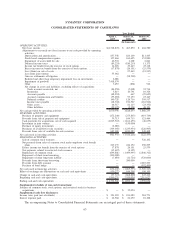Symantec 2009 Annual Report Download - page 129
Download and view the complete annual report
Please find page 129 of the 2009 Symantec annual report below. You can navigate through the pages in the report by either clicking on the pages listed below, or by using the keyword search tool below to find specific information within the annual report.related to fulfilling the obligations plus a normal profit margin. The estimated costs to fulfill the support contracts
are based on the historical direct costs related to providing the support.
For any given acquisition, we may identify certain pre-acquisition contingencies. If the contingency is
probable and can be reasonably estimated within the purchase price allocation period, generally within one year
after acquisition, an adjustment is recorded to goodwill. If the contingency is not probable or cannot be reasonably
estimated at the end of the purchase price allocation period, the adjustment is recorded in operating results in the
period in which the adjustment is determined.
Goodwill and Intangible Assets
Goodwill. Our methodology for allocating the purchase price relating to purchase acquisitions is determined
through established valuation techniques. Goodwill is measured as the excess of the cost of the acquisition over the
sum of the amounts assigned to tangible and identifiable intangible assets acquired less liabilities assumed. We
review goodwill for impairment on an annual basis during the fourth quarter of the fiscal year and whenever events
or changes in circumstances indicate the carrying value of goodwill may be impaired. In testing for a potential
impairment of goodwill, we determine the carrying value (book value) of the assets and liabilities for each reporting
unit, which requires the allocation of goodwill to each reporting unit. We then estimate the fair value of each
reporting unit. The first step of evaluating impairment is to determine if the estimated fair value is greater than the
carrying value of each reporting unit. If step one indicates that impairment potentially exists, the second step is
performed to measure the amount of impairment, if any. Goodwill impairment exists when the estimated fair value
of goodwill is less than its carrying value.
To determine the reporting units’ fair values in the current year analyses, we used the income approach under
which we calculate the fair value of each reporting unit based on the estimated discounted future cash flows of that
reporting unit. The results thereof are corroborated with the market approach which measures the value of an asset
through an analysis of recent sales or offerings of comparable property. When applied to the valuation of equity
interests, consideration is given to the financial condition and operating performance of the company being
appraised relative to those of publicly traded companies operating in the same or similar lines of business,
potentially subject to corresponding economic, environmental, and political factors and considered to be reasonable
investment alternatives. We also consider our market capitalization on the date of the analysis. The methodology
applied in the current year analysis was consistent with the methodology applied in the prior year analysis, but was
based on updated assumptions, as appropriate.
Our cash flow assumptions are based on historical and forecasted revenue, operating costs and other relevant
factors. To determine the reporting units’ carrying values in the current year evaluations, we allocated them based on
either specific identification or by using judgment for those assets and liabilities that are not held by reporting units but
rather by functional departments. Goodwill was allocated to the reporting units based on a combination of specific
identification and relative fair values, which is consistent with the methodology utilized in the prior year impairment
analysis. The use of relative fair values was necessary for certain reporting units due to changes in our operating
structure in prior years. The process of evaluating the potential impairment of goodwill requires significant judgment
at many points during the analysis, including determining the carrying value of the reporting units and calculating fair
value of each reporting unit based on estimated future cash flows and discount rates to be applied.
Prior to performing our second step in the goodwill impairment analysis, we perform an assessment of long-
lived assets for impairment. Such long-lived assets include tangible and intangible assets recorded in accordance
with SFAS No. 144, Impairment and Disposal of Long-Lived Assets and SFAS No. 86, Accounting for the Costs of
Computer Software to be Sold, Leased or Otherwise Marketed.
As defined in SFAS No. 142, we perform our goodwill impairment analysis at the reporting unit level, which
are the same as our operating segments, with the exception of the Services operating segment. We determined that
69
SYMANTEC CORPORATION
Notes to Consolidated Financial Statements — (Continued)
























